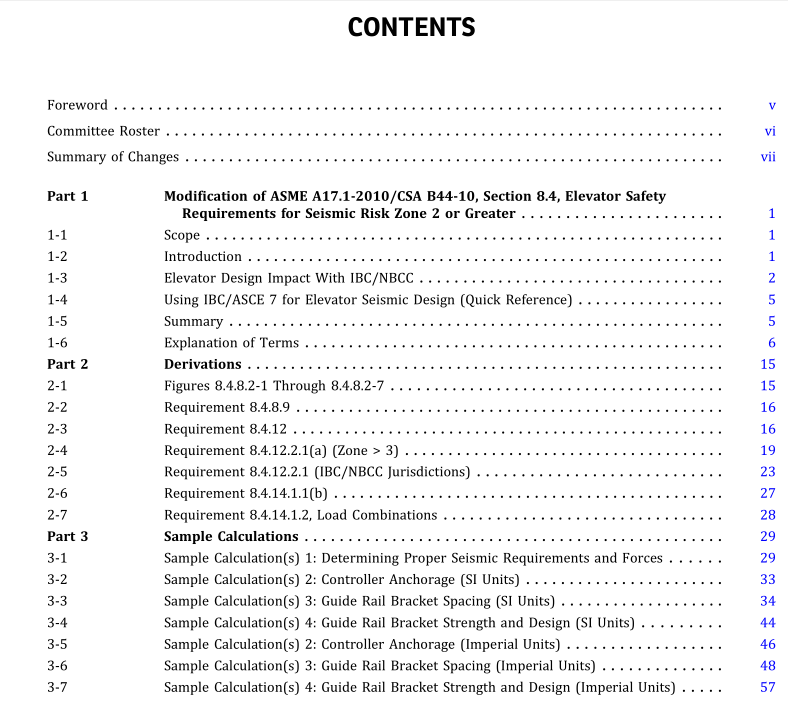ASME TR A17.1-8.4:2020 pdf download Guide for Elevator Seismic Design
1-1 SCOPE
This Technical Report provides rationale for elevator seismic force determination in ASME A17.1/CSA B44, Section8.4.ItdetailsASME A17.1/CSAB44harmonization efforts with all buildingcodes andsummarizes theharmo- nization impact on elevator design via force comparisons based on component, component mounting location, and building geographical location, and provides an Interna- tional Building Code (IBC) quick reference for seismic re- quirements and equivalent zone force levels.
1-2 INTRODUCTION Formanyyears,U.S.andCanadianmodelbuildingcodes such as the Uniform Building Code (UBC), Standard (Southern) Building Code (SBC), and National Building Code of Canada (NBCC) differentiated the force levels expected during seismic activity by zones. For example, a building in a zone 1 location was expected to see lower seismic forces than a building in a zone 2 location. A United States Geological Survey (USGS) map of the U.S. (see Figure 1-2-1), published in the various building codes, indicated the appropriate zone for any part of the country. Seismic requirements were first specified in ANSI/ ASME A17.1-1981, Appendix F. They were based on ANSI A58.1, the American National Standard Building Code Requirements for Minimum Design Loads in Build- ings and Other Structures. Seismic force levels that the elevator must withstand would vary based on whether the subject building was in a zone 2 or zone 3 location.
Zone 1 locations did not have elevator seismic require- ments. Therefore, to determine elevator seismic forces for any part ofthe country, one would review the appro- priate adopted building code for that particular location, determinethe zoneforthatlocation fromthe seismiczone map used by that building code, and then reference the appropriate elevator forces for that zone in ANSI/ASME A17.1. In the mid-1980s, the National Earthquake Hazard ReductionProgram(NEHRP) publisheditsRecommended Provisions forthe DevelopmentofSeismicRegulations for New Buildings with new seismic maps from the USGS. Instead of using zones, these new contour maps desig- nated seismic ground motion in terms of a velocity- related coefficient, A v .
The ground motion parameter, in addition to other building variables, was input into an equation to determine seismic force levels for building structural (buildings) and nonstructural components (elevators, escalators, etc.). Throughout the late 1980s and 1990s, the model building codes [Building Officials and Code Administrators International, Inc. (BOCA), UBC, SBC] began adopting these new maps and variations of the NEHRP seismic force equation into their codes.
In Canada, the 1985 edition of NBCC discarded Canada’s traditional seismic zones for seven seismic zones based on the velocity-related seismic zone parameter, Z v . With different building codes using different seismic force equations and no longer using traditional seismic zone maps, the need to properly align the ASME A17.1/CSA B44 seismic requirements with the new building codes became imperative. Requirement 8.4.13, introduced in the harmonized ASME A17.1/CSA B44 2000 edition, correlated ground motion parameters (such as A v and Z v ) to the traditional seismic zones. Using this correlation, the ASME A17.1/CSA B44 require- ments could continue to be used as written. For reference, the correlating values were as follows:
(U.S.: See ASME A17.1/CSA B44, 8.4.13.1)
Zone(s) Affected Peak Velocity Acceleration, A v
0 and 1 A v < 0.10
2 0.10 ≤ A v < 0.20
3 and 4 0.20 ≤ A v
(Canada: See ASME A17.1/CSA B44, 8.4.13.2)
Zone(s) Velocity-Related Seismic Zone, Z v
2 2 ≤ Z v < 4
≥ 3 Z v ≥ 4
NOTE: All future references in this Technical Report refer to ASME A17.1/CSA B44 unless otherwise stated.
In 1994, the three U.S. model building codes [Interna- tional Conference ofBuilding Officials (ICBO), BOCA, and Southern Building Code Conference International (SBCCI)] established the International Code Council (ICC). In 2000, ICC began publishing one comprehensive code, the International Building Code (IBC). The IBC 2000 code used the latestUSGS maps (nowcontourmaps with a ground motion parameter of earthquake spectral response acceleration) and NEHRP guidelines for its seismic force requirements. ASCE 7-02, recognized as the U.S. standard for seismic force requirements, was referenced by IBC 2003. As with IBC 2000, ASCE 7-02 and later editions referenced the latest USGS maps and NEHRP guidelines as the basis for its force requirements. Similar to IBC, the NBCC 2005 code used location-specific spectral response acceleration values (published in chart form) and NEHRP guidelines as the basis for its seismic force requirements.
ASME TR A17.1-8.4:2020 pdf download
